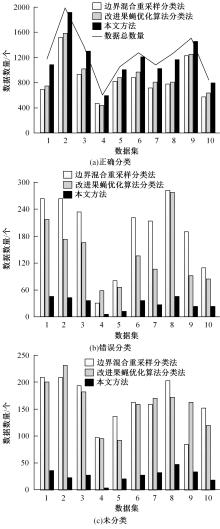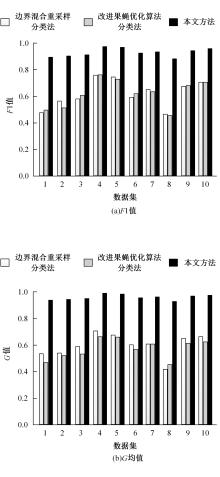吉林大学学报(工学版) ›› 2023, Vol. 53 ›› Issue (11): 3268-3273.doi: 10.13229/j.cnki.jdxbgxb.20220736
基于时间序列模糊分割的通信数据分类算法设计
- 1.南昌大学 科学技术学院,江西 九江 332020
2.南昌大学 数学与计算机学院,江西 南昌 330031
Design of communication data classification algorithm based on fuzzy segmentation of time series
- 1.College of Science and Technology,Nanchang University,Jiujiang 332020,China
2.School of Mathematics and Computer Sciences,Nanchang University,Nanchang 330031,China
摘要:
为解决通信数据集不平衡性明显导致分类难度大幅上升的问题,提出一种时间序列模糊分割的分类算法。利用主成分分析法取得特征值最大的特征矢量,根据区间数理论建立数据的时间序列,用数据与类别间的兰氏距离测度函数表征通信数据时间序列的分割目标,依据模糊分类矩阵差值与收敛条件的判定关系,获取模糊分割的分类结果。实验结果表明:本文算法3种分类情况的数据数量始终位于相应的理想水平上,正确性较高,错误性与失效性较低。
中图分类号:
- TP391
| 1 | 黄燚, 刘珍, 王若愚, 等. 移动互联网流量分类的多特征集合和多类别标签研究[J]. 计算机应用研究, 2020, 37(11): 3353-3358. |
| Huang Yi, Liu Zhen, Wang Ruo-yu, et al. Research on multi-feature sets and multi-class labels for mobile Internet traffic classification[J]. Computer Application Research, 2020, 37(11): 3353-3358. | |
| 2 | Huang W, Zhou S, Zhu T, et al. Privately publishing Internet of things data: bring personalized sampling into differentially private mechanisms[J]. IEEE Internet of Things Journal, 2021, 9(1): 80-91. |
| 3 | Li L, Zhang X, Yue W, et al. Cooperative search for dynamic targets by multiple UAVs with communication data losses[J]. ISA Transactions, 2021, 114(4): 230-241. |
| 4 | Mai K, Saeed W, Medi I. Churn prediction in digital game-based learning using data mining techniques: logistic regression, decision tree, and random forest[J]. Applied Soft Computing, 2022, 118(1): 108491. |
| 5 | Shen F, Liu Y, Wang R, et al. A dynamic financial distress forecast model with multiple forecast results under unbalanced data environment[J]. Knowledge-Based Systems, 2020, 192: 105365. |
| 6 | 侯贝贝, 刘三阳, 普事业. 基于边界混合重采样的非平衡数据分类方法[J]. 计算机工程与应用, 2020, 56(1): 46-52. |
| Hou Bei-bei, Liu San-yang, Pu Shi-ye. Imbalanced data classification method based on boundary mixed resampling[J]. Computer Engineering and Applications, 2020, 56(1): 46-52. | |
| 7 | 李锦珑, 包理群, 周彬. 改进果蝇优化算法及其在不平衡数据分类中的应用[J]. 西北师范大学学报: 自然科学版, 2021, 57(3): 57-61. |
| Li Jin-long, Bao Li-qun, Zhou Bin. Improved fruit fly optimization algorithm and its application in imbalanced data classification[J]. Journal of Northwest Normal University (Natural Science Edition), 2021, 57(3): 57-61. | |
| 8 | 陈清, 张程. 区间约束下移动终端用户偏好的数据挖掘模型[J]. 计算机仿真, 2020, 37(11):320-323. |
| Chen Qing, Zhang Cheng. Data mining model of mobile terminal user preference under interval constraints[J]. Computer Simulation, 2020, 37(11): 320-323. | |
| 9 | Huang L, Zhang Q, Zhang L, et al. Efficiency enhancement for underwater adaptive modulation and coding systems: via sparse principal component analysis[J]. IEEE Communications Letters, 2020, 24(8): 1808-1811. |
| 10 | 张海燕, 武晓蓓, 李娜. 基于非对称分布散点分位数的区间数据回归分析[J]. 统计与决策, 2022, 38(2): 26-32. |
| Zhang Hai-yan, Wu Xiao-bei, Li Na. Regression analysis of interval data based on scattered quantiles of asymmetric distribution[J]. Statistics and Decision-Making, 2022, 38(2): 26-32. | |
| 11 | 乔剑敏, 李沃源, 赵新平, 等. 一种有方案偏好的TOPSIS区间直觉模糊多属性决策方法[J]. 数学的实践与认识, 2020, 50(6): 322-328. |
| Qiao Jian-min, Li Wo-yuan, Zhao Xin-ping, et al. A TOPSIS interval intuitionistic fuzzy multi-attribute decision-making method with scheme preference[J]. Practice and Understanding of Mathematics, 2020, 50(6): 322-328. | |
| 12 | Wu X, Zhou H, Wu B, et al. A possibilistic fuzzy gath-geva clustering algorithm using the exponential distance[J]. Expert Systems with Applications, 2021, 184(5): 115550. |
| 13 | 沙秀艳, 尹传存, 徐泽水. 基于指数熵加权的降维犹豫模糊兰氏距离测度及应用[J]. 控制与决策, 2020, 35(3): 728-734. |
| Sha Xiu-yan, Yin Chuan-cun, Xu Ze-shui. Dimensionality reduction hesitant fuzzy rankine distance measurement and application based on exponential entropy weighting[J]. Control and Decision, 2020, 35(3): 728-734. | |
| 14 | 何新林, 戚宗锋, 李建勋. 基于隐变量后验生成对抗网络的不平衡学习[J]. 上海交通大学学报, 2021, 55(5): 557-565. |
| He Xin-lin, Qi Zong-feng, Li Jian-xun. Imbalanced learning based on latent variable posterior generative adversarial networks[J]. Journal of Shanghai Jiaotong University, 2021, 55(5): 557-565. | |
| 15 | Akram M, Ullah I, Alharbi M G. Methods for solving LR-Type pythagorean fuzzy linear programming problems with mixed constraints[J]. Mathematical Problems in Engineering, 2021(1): 1-29. |
| 16 | Lochbihler A. A mechanized proof of the max-flow min-cut theorem for countable networks with applications to probability theory[J]. Journal of Automated Reasoning, 2022(1): 1-26. |
| 17 | Dakulagi V, Bakhar M. Advances in smart antenna systems for wireless communication[J]. Wireless Personal Communications, 2020, 110(2): 931-957. |
| 18 | Chicco D, Jurman G. The advantages of the matthews correlation coefficient (MCC) over F1 score and accuracy in binary classification evaluation[J]. BMC Genomics, 2020, 21(6): 1-13. |
| 19 | 翁渊瀚, 李南. 基于时间序列模型的文本数据压缩存储算法[J]. 吉林大学学报: 工学版, 2023, 53(7): 2109-2114. |
| Weng Yuan-han, Li Nan. Text data compression storage algorithm based on time series model[J]. Journal of Jilin University(Engineering and Technology Edition), 2023,53(7): 2109-2114. | |
| 20 | 宋震,柳杰. 旋转机械振动频率时间序列预测算法[J]. 吉林大学学报: 工学版, 2022, 52(8): 1764-1769. |
| Song Zhen, Liu Jie. Vibration frequency time series prediction algorithm for rotating machinery[J]. Journal of Jilin University(Engineering and Technology Edition), 2022, 52(8): 1764-1769. |
| [1] | 宋世军,樊敏. 基于随机森林算法的大数据异常检测模型设计[J]. 吉林大学学报(工学版), 2023, 53(9): 2659-2665. |
| [2] | 翁渊瀚,李南. 基于时间序列模型的文本数据压缩存储算法[J]. 吉林大学学报(工学版), 2023, 53(7): 2109-2114. |
| [3] | 杜睿山,陈雨欣,孟令东. 可信云计算平台多源大数据时间序列调度算法[J]. 吉林大学学报(工学版), 2023, 53(11): 3194-3200. |
| [4] | 张朝刚,侍中楼,李敏. 基于多状态时间序列预测学习的超精密机床主轴故障诊断仿真[J]. 吉林大学学报(工学版), 2023, 53(11): 3056-3061. |
| [5] | 宋震,柳杰. 旋转机械振动频率时间序列预测算法[J]. 吉林大学学报(工学版), 2022, 52(8): 1764-1769. |
| [6] | 陈涛, 崔岳寒, 郭立民. 适用于单快拍的多重信号分类改进算法[J]. 吉林大学学报(工学版), 2018, 48(3): 952-956. |
| [7] | 刘舒, 姜琦刚, 朱航, 李晓东. 基于Hyb-F组合滤波算法的向海自然保护区NDVI时间序列重构[J]. 吉林大学学报(工学版), 2018, 48(3): 957-967. |
| [8] | 万平, 吴超仲, 林英姿, 马晓凤. 基于驾驶行为多元时间序列特征的愤怒驾驶状态检测[J]. 吉林大学学报(工学版), 2017, 47(5): 1426-1435. |
| [9] | 王寅同, 王建东, 陈海燕. 时间序列降维及机场噪声中的机型识别[J]. 吉林大学学报(工学版), 2016, 46(4): 1202-1208. |
| [10] | 王石, 隋永新, 董琰, 杨怀江. 基于改进型小数据量法的局域网流量预测[J]. 吉林大学学报(工学版), 2016, 46(4): 1254-1260. |
| [11] | 司伟建, 李晓林. 基于压缩思想的低运算近场信号估计算法[J]. 吉林大学学报(工学版), 2015, 45(3): 991-997. |
| [12] | 郑寇全,雷英杰,王睿,余晓东. 基于矢量量化的长期直觉模糊时间序列预测[J]. 吉林大学学报(工学版), 2014, 44(3): 795-780. |
| [13] | 刘寒冰, 李国恒, 谭国金, 孙晏一. 基于时间序列的边坡位移实时预测方法[J]. 吉林大学学报(工学版), 2012, 42(增刊1): 193-197. |
| [14] | 张勇, 关伟. 预测交通流量时间序列的组合动态建模方法[J]. 吉林大学学报(工学版), 2010, 40(05): 1209-1214. |
| [15] | 赵志强,张毅,胡坚明. 基于GTM-TT算法的城市区域交通状态分析[J]. 吉林大学学报(工学版), 2009, 39(增刊2): 1-0006. |
|




